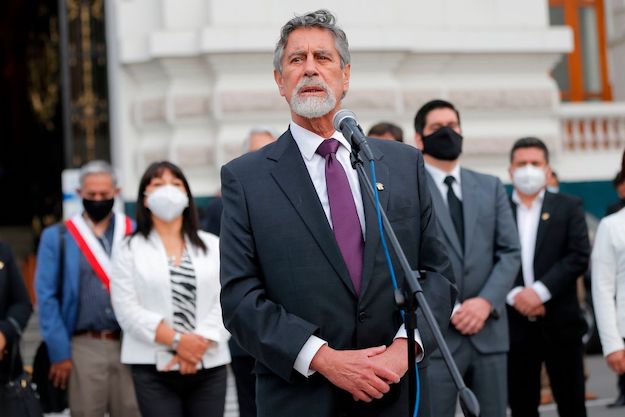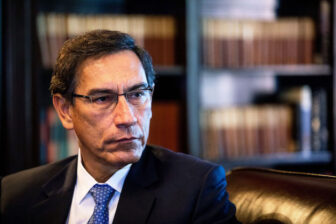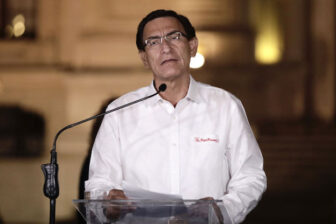Peru’s new president, Francisco Sagasti, has spent decades grappling with how to best address severe political crises.
I was doing research in Peru in 1993 when, in the aftermath of then-president Alberto Fujimori’s autogolpe (self-coup), Sagasti’s newly formed think tank Agenda Peru gathered social scientists and other public intellectuals for a series of forums, brainstorming how to protect what remained of the country’s democratic institutions while tackling poverty, economic crisis, and ongoing violence.
Decades later, as Peru emerges from a week of upheaval and police violence, and as the country looks to upcoming elections in April 2021, this depth of experience is part of what makes Sagasti a good steward. Still, he faces real challenges in the short eight months he will be president of Peru.
Though the 76-year-old Sagasti only entered congressional politics in 2016, his professional background is that of a man who has thought long and hard about how to approach complex political problems. He holds a doctorate from the University of Pennsylvania; he has worked for the United Nations, the World Bank and the Peruvian Foreign Ministry. More important than this technocratic experience, however, is his demonstrated commitment to defending democratic norms. Years before mass protests against Fujimori’s illegitimate government broke out in 2000, Sagasti traveled the country with Agenda Peru, consulting with civil society leaders about good governance policies and raising the alarm about the Fujimori regime’s brutal, authoritarian rule.
At his core, Sagasti, a member of the centrist Purple Party, is a bridge-builder who believes in dialogue — though this is not the picture Peru’s reactionary right-wing wants to paint. In 1996, Sagasti was among those kidnapped when the Movimiento Revolucionario Túpac Amaru (MRTA) rebel group took hundreds of hostages at the Japanese Embassy. Released on the second day of the holdout, Sagasti asked several MRTA leaders to sign the diary that he’d kept during the siege. Some in the far-right have seized on this, calling Sagasti a “terrorist sympathizer.” Voting against Sagasti’s confirmation on Nov. 17, some members of Congress said they voted no “to honor” the victims of guerrilla violence.
Working with Congress will be a major challenge for Sagasti’s interim presidency. Since 2016, Peruvian politics have been defined by an intensely confrontational relationship between the executive and legislative branch, triggered by opposition leader Keiko Fujimori’s refusal to recognize her defeat in that year’s presidential elections. Those same executive-legislative clashes drove efforts to successfully push President Pedro Pablo Kuczynski to resign in 2018; they later prompted Kucyznski’s successor, Martín Vizcarra, to dissolve Congress in 2019 and call for new elections. Congressional opposition to Vizcarra’s modest proposed political reforms — including a prohibition against the immediate re-election of members of Congress and an end to parliamentary immunity, meaning the 68 members of Congress under investigation for various crimes would be at greater risk of being held accountable — is what led to Vizcarra’s illegitimate removal on Nov. 10, sparking the current crisis.
Ninety-five out of 130 members of Congress voted to confirm Sagasti as president. Some might argue that’s a vote of confidence, but it doesn’t change the fundamental issue: There remains a powerful coalition in Congress with a strong interest in keeping themselves in power and protecting themselves from prosecution.
Sagasti will also have to navigate deciding how to treat the outgoing government. The courageous Peruvians who took to the streets to reject the illegitimate ouster of Martín Vizcarra and the power-grab by head of Congress Manuel Merino are the reason Sagasti is in power today. They demand that those responsible for Merino’s illegal takeover and the subsequent violence against peaceful protestors be held accountable. Peru’s attorney general’s office has already opened an investigation into potential human rights violations committed by Merino, his prime minister and long-time right-wing politician Antero Flores Aráoz, and interior minister Gastón Rodríguez.
The other critical question facing Sagasti is whether he will support efforts to identify and sanction those among the national police who gave orders to beat and fire ammunition directly at peaceful protestors, leaving scores injured and killing 24-year-old Inti Sotelo Camargo and 22-year-old Jack Bryan Pintado Sánchez. In an important gesture, Sagasti invited the families of Sotelo Camargo and Pintado Sánchez to his inauguration, acknowledging the two martyrs by name and affirming, “there will not be impunity.” But Peru must also reform its security forces, ensuring that police agents never again violently repress protestors. This will mean holding accountable those responsible for ordering excessive force, and changing a law passed earlier this year that exempts police and soldiers from being sanctioned for abuses.
In quoting Peru’s beloved and anguished poet César Vallejo at the end of his inauguration speech, Sagasti made it clear that he sees uniting the country as a central goal. Ensuring that April’s elections are both free and fair will be critical to ensuring that Peru overcomes the current crisis, and Sagasti understands this. But as Peruvian political scientist Eduardo Dargent told me, “The authoritarian state still lies in wait for an opportunity.” If the illegitimate efforts to drive out Vizcarra had been led by “less clumsy and more popular political figures,” he said, “this could have been much worse.”
—
Burt is an associate professor at the Schar School of Policy and Government at George Mason University and a senior fellow at the Washington Office on Latin America (WOLA). She is the author of Political Violence and the Authoritarian State in Peru: Silencing Civil Society (Palgrave, 2007).








